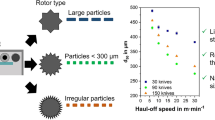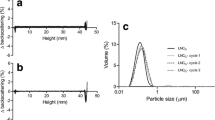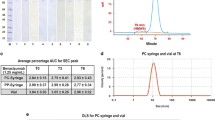Abstract
In this study, we present an innovative and facile in situ approach for extemporaneous preparation of sterile microparticles. An amazingly simple approach, in situ technology circumvents the stability, and scale up challenges as well as sterilization issues associated with long-acting particulate systems. Monophasic preconcentrates of donepezil base (DPZ), a model drug with a biodegradable polymer poly (dl-lactide-co-glycolide) (PLGA), with stabilizer were prepared by simple solution and sterilized by filtration (0.22 micron). The sterile preconcentrates when added to aqueous dextrose solution (total volume < 3 mL) generated ready-to-inject DPZ PLGA microparticles (DPZ-PLGA-MP) with high reproducibility, entrapment efficiency (> 80%), and size ~ 80 micron. DPZ micro suspension (DPZ-MS) with high precipitation efficiency (> 90%) and size ~ 80 micron was obtained in a similar manner omitting PLGA. XRD and DSC study confirmed decreased crystallinity in the presence of PLGA. No interaction between PLGA and DPZ was evident in the FTIR study. The microparticulate dispersions exhibited good in vitro injectability when tested using the texture analyzer (force < 5 N). When evaluated using the dialysis bag method (Himedia 12–14 kDa molecular weight cutoff), both microparticulate formulations exhibited controlled release up to 1 week in vitro. Further, low burst release of ~ 10% at the end of 6 h in the ex vivo chicken muscle study proposes great promise. Our data propose the facile extemporaneous generation of microparticles as a practical and promising approach for development of long-acting injectables. This facile approach could serve as platform technology for other drug candidates.
Graphical Abstract




Similar content being viewed by others
References
Burgess DJ, Wright JC. An introduction to long acting injections and implants. In: Wright JC, Burgess DJ, editors. Long Acting Injections and Implants [Internet]. Boston, MA: Springer US; 2012. p. 1–9. Available from: https://doi.org/10.1007/978-1-4614-0554-2_1.
Wang Y, Burgess DJ. Microsphere technologies. In: Long Acting Injections and Implants [Internet]. Boston, MA: Springer US; 2012. p. 167–94. Available from: https://doi.org/10.1007/978-1-4614-0554-2_10.
Lee BK, Yun Y, Park K. PLA micro- and nano-particles. Adv Drug Deliv Rev. 2016;15(107):176–91. https://doi.org/10.1016/j.addr.2016.05.020.
Jalil R, Nixon JR. Biodegradable poly(lactic acid) and poly(lactide-co-glycolide) microcapsules: problems associated with preparative techniques and release properties. J Microencapsul. 1990;7(3):297–325. https://doi.org/10.3109/02652049009021842.
Baras B, Benoit MA, Gillard J. Parameters influencing the antigen release from spray-dried poly (DL-lactide) microparticles. Int J Pharm. 2000;200(1):133–45. https://doi.org/10.1016/S0378-5173(00)00363-X.
Lee WY, Asadujjaman M, Jee JP. Long acting injectable formulations: the state of the arts and challenges of poly (lactic-co-glycolic acid) microsphere, hydrogel, organogel and liquid crystal. J Pharm Investig. 2019;49(4):459–76. https://doi.org/10.1007/s40005-019-00449-9.
Hasanain F, Guenther K, Mullett WM, Craven E. Gamma sterilization of pharmaceuticals—a review of the irradiation of excipients, active pharmaceutical ingredients, and final drug product formulations. PDA J Pharm Sci Technol. 2014;68(2):113–37. https://doi.org/10.5731/pdajpst.2014.00955.
Lee JS, Chae GS, Khang G, Kim MS, Cho SH, Lee HB. The effect of gamma irradiation on PLGA and release behavior of BCNU from PLGA wafer. Macromol Res. 2003;11(5):352–6. https://doi.org/10.1007/BF03218376.
Bodmeier R. Multiphase system. EP0996426A1, 2000 May 03. https://patents.google.com/patent/EP0996426A1/en.
Kranz H, Bodmeier R. A biodegradable in situ forming system for controlled drug release. Pharm Sci Suppl. 1998;1:414.
Kranz H, Brazeau GA, Napaporn J, Martin RL, Millard W, Bodmeier R. Myotoxicity studies of injectable biodegradable in-situ forming drug delivery systems. Int J Pharm. 2001;212(1):11–8. https://doi.org/10.1016/S0378-5173(00)00568-8.
Kranz H, Bodmeier R. A novel in situ forming drug delivery system for controlled parenteral drug delivery. Int J Pharm. 2007;332(1–2):107–14. https://doi.org/10.1016/j.ijpharm.2006.09.033.
Körber M, Bodmeier R. Development of an in situ forming PLGA drug delivery system: I. Characterization of a non-aqueous protein precipitation. European Journal of Pharmaceutical Sciences. 2008 Nov 15;35(4):283–292. https://doi.org/10.1016/j.ejps.2008.07.007.
Luan X, Bodmeier R. In situ forming microparticle system for controlled delivery of leuprolide acetate: influence of the formulation and processing parameters. Eur J Pharm Sci. 2006;27(2–3):143–9. https://doi.org/10.1016/j.ejps.2005.09.002.
Li J, Chen F, Hu C, He L, Yan K, Zhou L, et al. Optimized preparation of in situ forming microparticles for the parenteral delivery of vinpocetine. Chem Pharm Bull. 2008;56(6):796–801. https://doi.org/10.1248/cpb.56.796.
Haider M, Elsayed I, Ahmed IS, Fares AR. In situ-forming microparticles for controlled release of rivastigmine: in vitro optimization and in vivo evaluation. Pharmaceuticals. 2021;14(1):66. https://doi.org/10.3390/ph14010066.
Parent M, Boudier A, Perrin J, Vigneron C, Maincent P, Violle N, et al. In situ microparticles loaded with s-nitrosoglutathione protect from stroke. PLoS ONE. 2015 Dec 8;10(12):e0144659. https://doi.org/10.1371/journal.pone.0144659.
D’Souza AA, Yevate SV, Bandivdekar A, Devarajan PV. In situ polyethylene sebacate particulate carriers as an alternative to Freund’s adjuvant for delivery of a contraceptive peptide vaccine—a feasibility study. Int J Pharm. 2015;496(2):601–8. https://doi.org/10.1016/j.ijpharm.2015.10.070.
Kapse SV, Gaikwad RV, Samad A, Devarajan PV. Self nanoprecipitating preconcentrate of tamoxifen citrate for enhanced bioavailability. Int J Pharm. 2012;429(1):104–12. https://doi.org/10.1016/j.ijpharm.2012.02.042.
John R, Dalal B, Shankarkumar A, Devarajan PV. Innovative betulin nanosuspension exhibits enhanced anticancer activity in a triple negative breast cancer cell line and zebrafish angiogenesis model. International Journal of Pharmaceutics. 2021 May 1;600:120511. https://doi.org/10.1016/j.ijpharm.2021.120511.
Joshi VM, Devarajan PV. Receptor-mediated hepatocyte-targeted delivery of primaquine phosphate nanocarboplex using a carbohydrate ligand. Drug Deliv Transl Res. 2014;4(4):353–64. https://doi.org/10.1007/s13346-014-0200-4.
Jindal AB, Bachhav SS, Devarajan PV. In situ hybrid nano drug delivery system (IHN-DDS) of antiretroviral drug for simultaneous targeting to multiple viral reservoirs: An in vivo proof of concept. Int J Pharm. 2017;521(1–2):196–203. https://doi.org/10.1016/j.ijpharm.2017.02.024.
Jahagirdar PS, Gupta PK, Kulkarni SP, Devarajan PV. Polymeric curcumin nanoparticles by a facile in situ method for macrophage targeted delivery. Bioengineering & Translational Medicine. 2019;4(1):141–51. https://doi.org/10.1002/btm2.10112.
Jindal AB, Devarajan PV. Asymmetric lipid–polymer particles (LIPOMER) by modified nanoprecipitation: role of non-solvent composition. Int J Pharm. 2015;489(1):246–51. https://doi.org/10.1016/j.ijpharm.2015.04.073.
Van Krevelen DW, Te Nijenhuis K. Properties of polymers: their correlation with chemical structure; their numerical estimation and prediction from additive group contributions. Elsevier; 2009.
Ferrell WH, Kushner DI, Hickner MA. Investigation of polymer–solvent interactions in poly (styrene sulfonate) thin films. J Polym Sci, Part B: Polym Phys. 2017;55(18):1365–72. https://doi.org/10.1002/polb.24383.
Liu Q, Zhang H, Zhou G, Xie S, Zou H, Yu Y, et al. In vitro and in vivo study of thymosin alpha1 biodegradable in situ forming poly (lactide-co-glycolide) implants. Int J Pharm. 2010;397(1–2):122–9. https://doi.org/10.1016/j.ijpharm.2010.07.015.
Ahmed TA, Ibrahim HM, Ibrahim F, Samy AM, Kaseem A, Nutan MT, et al. Development of biodegradable in situ implant and microparticle injectable formulations for sustained delivery of haloperidol. J Pharm Sci. 2012;101(10):3753–62. https://doi.org/10.1002/jps.23250.
D’Souza SS, DeLuca PP. Development of a dialysis in vitro release method for biodegradable microspheres. AAPS pharmscitech. 2005;6(2):E323-E328. https://doi.org/10.1208/pt060242.
Kamali H, Khodaverdi E, Hadizadeh F, Mohajeri SA, Kamali Y, Jafarian AH. In-vitro, ex-vivo, and in-vivo release evaluation of in situ forming buprenorphine implants using mixture of PLGA copolymers and additives. Int J Polym Mater Polym Biomater. 2019;68(16):965–77. https://doi.org/10.1080/00914037.2018.1525541.
Dawre S, Pathak S, Sharma S, Devarajan PV. Enhanced antimalalarial activity of a prolonged release in situ gel of arteether–lumefantrine in a murine model. Eur J Pharm Biopharm. 2018;1(123):95–107. https://doi.org/10.1016/j.ejpb.2017.11.002.
Stainmesse S, Fessi H, Devissaguet J-P, Puisieux F, Theis C. Process for preparing dispersible colloidal systems of a substance in nanoparticulate form. US5133908A, 1992 July 28. https://patents.google.com/patent/US5133908A/en.
Joshi HA, Patwardhan RS, Sharma D, Sandur SK, Devarajan PV. Pre-clinical evaluation of an innovative oral nano-formulation of baicalein for modulation of radiation responses. International Journal of Pharmaceutics. 2021 Feb 15;595:120181. https://doi.org/10.1016/j.ijpharm.2020.120181.
Badkar AV, Gandhi RB, Davis SP, LaBarre MJ. Subcutaneous delivery of high-dose/volume biologics: current status and prospect for future advancements. DDDT. 2021;15:159–70. https://doi.org/10.2147/DDDT.S287323.
Hancock BC, York P, Rowe RC. The use of solubility parameters in pharmaceutical dosage form design. Int J Pharm. 1997;148(1):1–21. https://doi.org/10.1016/S0378-5173(96)04828-4.
Jain A, Kunduru KR, Basu A, Mizrahi B, Domb AJ, Khan W. Injectable formulations of poly(lactic acid) and its copolymers in clinical use. Adv Drug Deliv Rev. 2016;15(107):213–27. https://doi.org/10.1016/j.addr.2016.07.002.
Lancheros R, Guerrero CA, Godoy-Silva RD. Improvement of N-acetylcysteine loaded in PLGA nanoparticles by nanoprecipitation method. Journal of Nanotechnology. 2018 Jan 1;2018:https://doi.org/10.1155/2018/3620373.
Legrand P, Lesieur S, Bochot A, Gref R, Raatjes W, Barratt G, et al. Influence of polymer behaviour in organic solution on the production of polylactide nanoparticles by nanoprecipitation. Int J Pharm. 2007;344(1–2):33–43. https://doi.org/10.1016/j.ijpharm.2007.05.054.
Lepeltier E, Bourgaux C, Couvreur P. Nanoprecipitation and the “Ouzo effect”: application to drug delivery devices. Adv Drug Deliv Rev. 2014;1(71):86–97. https://doi.org/10.1016/j.addr.2013.12.009.
Galindo-Rodriguez S, Allémann E, Fessi H, Doelker E. Physicochemical parameters associated with nanoparticle formation in the salting-out, emulsification-diffusion, and nanoprecipitation methods. Pharm Res. 2004;21(8):1428–39. https://doi.org/10.1023/B:PHAM.0000036917.75634.be.
Rivas CJ, Tarhini M, Badri W, Miladi K, Greige-Gerges H, Nazari QA, et al. Nanoprecipitation process: from encapsulation to drug delivery. Int J Pharm. 2017;532(1):66–81. https://doi.org/10.1016/j.ijpharm.2017.08.064.
Fredenberg S, Wahlgren M, Reslow M, Axelsson A. The mechanisms of drug release in poly (lactic-co-glycolic acid)-based drug delivery systems—a review. Int J Pharm. 2011;415(1–2):34–52. https://doi.org/10.1016/j.ijpharm.2011.05.049.
Acharya G, Shin CS, Vedantham K, McDermott M, Rish T, Hansen K, et al. A study of drug release from homogeneous PLGA microstructures. J Control Release. 2010;146(2):201–6. https://doi.org/10.1016/j.jconrel.2010.03.024.
Li XS, Wang JX, Shen ZG, Zhang PY, Chen JF, Yun J. Preparation of uniform prednisolone microcrystals by a controlled microprecipitation method. Int J Pharm. 2007;342(1–2):26–32. https://doi.org/10.1016/j.ijpharm.2007.04.025.
Homayouni A, Sadeghi F, Varshosaz J, Garekani HA, Nokhodchi AHomayouni. Promising dissolution enhancement effect of soluplus on crystallized celecoxib obtained through antisolvent precipitation and high pressure homogenization techniques. Colloids Surf B. 2014 Oct 1;122:591–600. https://doi.org/10.1016/j.colsurfb.2014.07.037.
Guo W, Quan P, Fang L, Cun D, Yang M. Sustained release donepezil loaded PLGA microspheres for injection: preparation, in vitro and in vivo study. Asian J Pharm Sci. 2015;10(5):405–14. https://doi.org/10.1016/j.ajps.2015.06.001.
Mittapelly N, Thalla M, Pandey G, Banala VT, Sharma S, Arya A, et al. Long acting ionically paired embonate based nanocrystals of donepezil for the treatment of Alzheimer’s disease: a proof of concept study. Pharm Res. 2017;34(11):2322–35. https://doi.org/10.1007/s11095-017-2240-1.
Krayukhina E, Fukuhara A, Uchiyama S. Assessment of the injection performance of a tapered needle for use in prefilled biopharmaceutical products. J Pharm Sci. 2020;109(1):515–23. https://doi.org/10.1016/j.xphs.2019.10.033.
Korsmeyer RW, Gurny R, Doelker E, Buri P, Peppas NA. Mechanisms of solute release from porous hydrophilic polymers. Int J Pharm. 1983;15(1):25–35. https://doi.org/10.1016/0378-5173(83)90064-9.
Wang X, Burgess DJ. Drug release from in situ forming implants and advances in release testing. Adv Drug Deliv Rev. 2021;1(178): 113912.
Funding
The authors are thankful to the Government of India, Department of Science & Technology (DST) and Amaterasu Lifesciences LLP, Mumbai, for the Prime Minister Fellowship and financial support.
Author information
Authors and Affiliations
Contributions
Sukhada S. Shevade: investigation, data curation, writing—first draft; Maharukh T. Rustomjee: conceptualization, supervision, project administration, resources. Padma V. Devarajan: conceptualization, supervision, validation, resources, writing—review and editing of final draft.
Corresponding author
Ethics declarations
Conflict of Interest
The authors declare no competing interests.
Additional information
Publisher's Note
Springer Nature remains neutral with regard to jurisdictional claims in published maps and institutional affiliations.
Supplementary Information
Below is the link to the electronic supplementary material.
Rights and permissions
Springer Nature or its licensor (e.g. a society or other partner) holds exclusive rights to this article under a publishing agreement with the author(s) or other rightsholder(s); author self-archiving of the accepted manuscript version of this article is solely governed by the terms of such publishing agreement and applicable law.
About this article
Cite this article
Shevade, S.S., Rustomjee, M.T. & Devarajan, P.V. Facile Technology for Extemporaneous Preparation of Long-Acting Injectable Microparticulate Suspensions at the Patient Side. AAPS PharmSciTech 24, 61 (2023). https://doi.org/10.1208/s12249-023-02519-6
Received:
Accepted:
Published:
DOI: https://doi.org/10.1208/s12249-023-02519-6




